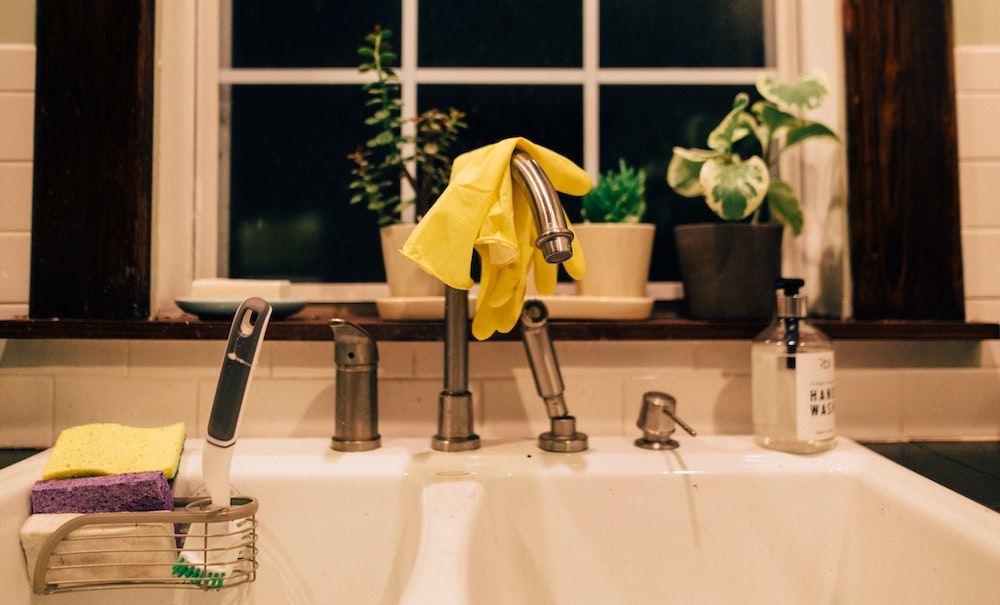Leak Under Kitchen Sink When Water Is Turned On or Off

In the realm of household nuisances, discovering a leak under your kitchen sink is up there with the most irksome.
Not only can it lead to potential damage to your cupboards and flooring, but it also has the potential to rack up an unpleasant water bill if left unchecked.
It's a sight that can fill any homeowner with dread: opening the under-sink cupboard to grab the washing up liquid, only to find a growing pool of water.
So, what causes these leaks, and more importantly, how can you fix them?
In this post, we'll dive into the common reasons for leaks under the kitchen sink, how to locate the source, and tips on tackling this issue before it turns into a bigger problem.
Let's roll up our sleeves and get to it!
Click here to see our complete range of 1810 kitchen sinks...
Leak Under Kitchen Sink When Water Is Turned On
A leak under the kitchen sink that only appears when the water is turned on is usually a clear sign of an issue with your sink's plumbing.
It's important to note that the source of the leak may not always be directly above the puddle of water, as water can travel along pipes before dripping down.
Here are a few common reasons why this might be happening:
- Loose Connections: Your kitchen sink's plumbing system consists of various pipes, connectors, and joints. If any of these have become loose over time, they could start leaking when the water is turned on and pressure is applied to the system.
- Damaged Seals: Over time, the seals around your sink or tap can wear out and no longer provide a water-tight connection. When the water is running, it can leak out from these damaged seals.
- Cracked Pipes: Although less common, physical damage to the pipes, such as cracks or holes, can cause leaks. These leaks become noticeable when the water is turned on and flows past the damaged area.
- Faulty Water Supply Lines: The water supply lines that connect your sink to your home's water supply can also be the source of leaks. These pipes can become worn over time, or their connections may loosen, causing water to leak out when the tap is turned on.
- Drain Leaks: If the water drains out normally when the tap is running, but you notice a leak under the sink, it's likely the issue lies with the drain assembly. This could be due to a faulty or deteriorated sink strainer, loose connections along the drain pipe, or even a crack in the drain pipe itself.
The first step to solving this issue is to pinpoint the source of the leak, which may require a bit of investigation.
Once you've identified where the water is coming from, you can take appropriate steps to fix the leak or call in a professional if needed.
(Checkout this link to buy kitchen sinks online).
Leak Under Kitchen Sink When the Water is Off
A leak under the kitchen sink even when the water is turned off is a situation that requires prompt attention.
It suggests a persistent issue that can potentially cause water damage and mould growth if left unchecked.
There are a few key reasons why this might be occurring:
- Failing Seals or Gaskets: Over time, seals or gaskets can deteriorate due to wear and tear or ageing, allowing water to seep through even when the water supply is off. This is commonly seen around sink flanges, tap base, or connections in your pipework.
- Pipe Corrosion: Metal pipes, particularly older ones, can corrode over time due to chemical reactions with the water and the material of the pipe. This can eventually lead to small holes or cracks in the pipe, allowing water to leak out continuously.
- Damaged Valves: If the shut-off valve is damaged or faulty, it may not be able to completely halt the flow of water, leading to leaks even when the water is turned off.
- High Water Pressure: If your home's water pressure is excessively high, it could cause a continuous leak. This often presents as a leak that continues for a while after the water has been turned off.
- Loose or Damaged Supply Lines: The water supply lines that connect your sink to the main water supply can become worn or damaged, or their connections might loosen over time. This can cause water to leak out continuously.
- Drainage Issue: Occasionally, the issue isn't with the water supply at all. Instead, a slow-draining pipe or a blockage can cause water to back up and leak out of the drainage system.
Identifying the exact cause of the leak when the water is off might require a bit more detective work since there isn't the clear indication of a running tap to guide you.
However, once you find the source of the leak, you can take steps to address the problem, whether that involves tightening connections, replacing seals, or calling in a plumber for more complex issues.
How to Fix a Leak Under Kitchen Sink
Fixing a leak under your kitchen sink depends on the source of the leak.
However, here's a general guide to tackle some of the common issues:
- Safety First: Before you start any work, make sure the water supply to the sink is turned off to prevent any accidental spillage. Also, have a bucket or towels ready to catch any residual water in the pipes.
- Loose Connections: If the leak is due to loose connections, it might be as simple as tightening the problematic joint. Use an adjustable spanner or pipe wrench to carefully tighten any loose connections. Be careful not to overtighten, as this can damage the fittings.
- Damaged Seals: If the leak is coming from a worn-out seal or gasket, you will need to replace it. First, remove the old seal, clean the area thoroughly, and then apply the new seal according to the manufacturer's instructions. Make sure you get the correct size seal for your fittings.
- Cracked Pipes: If a pipe is cracked, it will likely need to be replaced. Depending on the location and severity of the crack, you may be able to do this yourself, or you may need to hire a professional plumber.
- Faulty Water Supply Lines: If the water supply lines are faulty, replacement is typically the best option. Ensure that you replace them with lines of the same size and type. If you're unsure, take the old line to a DIY shop to find a suitable replacement.
- Drain Leaks: If the drain pipe is leaking, first try tightening the slip nuts using a pipe wrench. If the leak continues, you may need to replace the washer inside the slip nut or replace the entire drain assembly. If the sink strainer is leaking, it will need to be removed and reinstalled with a fresh layer of plumber's putty.
- Sealing Joints: For minor leaks around joints, you might find applying a joint compound or using Teflon tape (PTFE tape) helps to seal the area.
After making any fixes, it's important to test your work.
Turn the water back on and check to see if the leak has stopped.
If the problem persists, it may be best to call in a professional to avoid causing further damage.
Remember, while DIY can save you a bit of money, if you're unsure about any aspect of the repair, it's better to call in a plumber.
They have the skills and experience to handle a variety of issues and can ensure that repairs are carried out safely and effectively.
(Click here to see our complete range of kitchen taps for sale online).
How to Tell if You Need to Buy a New Kitchen Sink?
Knowing when it's time to invest in a new kitchen sink is an important part of maintaining a functional, efficient and attractive kitchen.
Below are some telltale signs that it might be time to consider a replacement:
- Persistent Leaks: If your sink continually leaks despite multiple attempts at repair, it may be time to replace it. Persistent leaks can indicate a problem that's more than skin-deep, like a crack in the basin or serious sealing issues.
- Visible Damage: Dents, cracks, chips, or scratches that are deep enough to penetrate the surface of the sink can be signs that it's time for a new one. Not only can they detract from the aesthetic of your kitchen, but they can also lead to bigger issues down the line, like leaks or rust.
- Stains and Discolouration: Some materials, like porcelain or enamel, can develop stubborn stains or discolouration over time. If these can't be removed with regular cleaning or mild abrasive cleaners, it could be time to consider a new sink.
- Rust: If you notice rust on a stainless steel or cast iron sink, it might be time to think about a replacement. Rust can indicate a compromise in the sink's material and can lead to leaks if left untreated.
- Outdated Style: Sometimes, the issue isn't about functionality but rather aesthetics. If your sink looks dated and no longer fits with your kitchen's decor, or if you're planning a complete kitchen remodel, it could be the perfect time for an upgrade.
- Inadequate Size or Functionality: Over time, your needs may change. If you find that your current sink is too small for your needs, doesn't have enough basins, or lacks features that would make your kitchen tasks easier (like a built-in drainboard or lower divider), it may be worth investing in a new kitchen sink that better suits your lifestyle.
- Poor Material Quality: Lower-quality sink materials can deteriorate quicker over time. If your sink is made from a material that's prone to damage, replacing it with a higher-quality material can be a good long-term investment.
Keep in mind that while replacing a sink can be a DIY project, it can also be complex depending on the type of sink and counter you have.
Don't hesitate to call in a professional if needed.
Some Advice From a Professional Kitchen Fitter
I have worked installing and repairing kitchens for a very long time, you might even say I am an expert at it.
One the common calls outs I get is to fix bodged DIY attempts!
So unless you are very confident and competent at fixing leaks, I would suggest you call out a local plumber to fix your kitchen sink.
Final Notes On Leaks Under Kitchen Sinks
In conclusion, knowing when to replace your kitchen sink is integral to maintaining a functional, stylish and efficient kitchen.
Persistent leaks, visible damage such as cracks, chips or deep scratches, and stubborn stains or discolouration are all clear indicators of a sink that's past its prime.
Furthermore, signs of rust on stainless steel or cast iron sinks can highlight the need for a replacement.
The aesthetics of your sink also play a key role; an outdated style might urge you to consider an upgrade, particularly if a complete kitchen remodel is on the cards.
Similarly, if your current sink doesn't suit your lifestyle or needs in terms of size and functionality, a new sink could be a worthwhile investment.
Lastly, low-quality material that's prone to damage over time is a good reason to switch to a more durable sink.
As always, whilst it's possible to replace a sink as a DIY task, don't hesitate to bring in professional help if needed to ensure the job is done correctly and safely.


